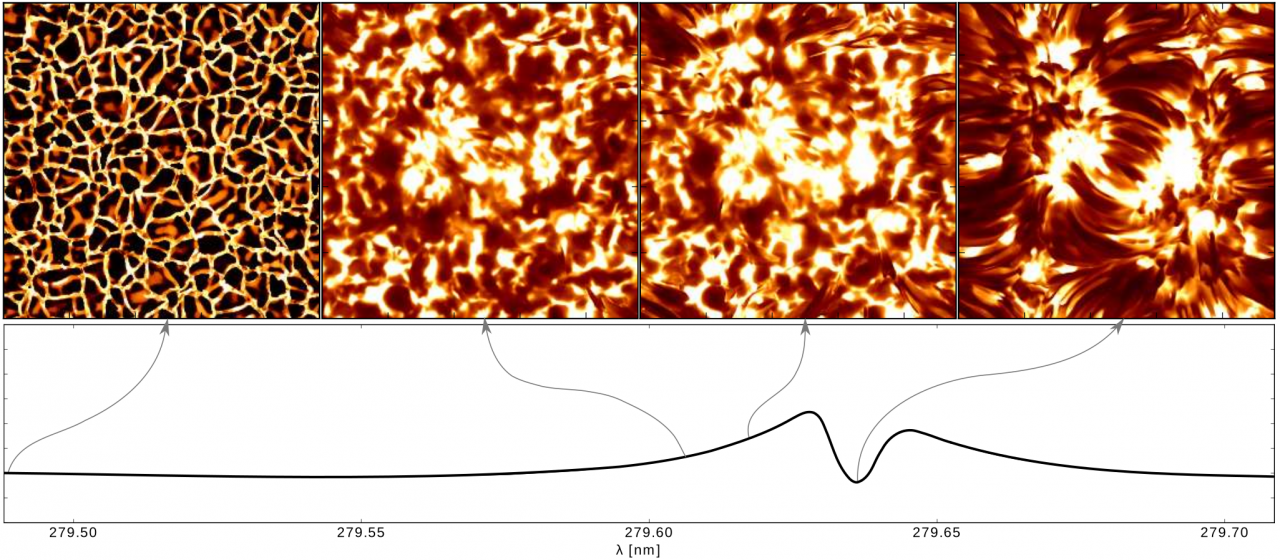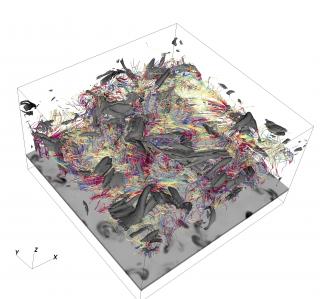General
Los campos magnéticos están presentes en todos los plasmas astrofísicos y controlan la mayor parte de la variabilidad que se observa en el Universo a escalas temporales intermedias. Se encuentran en estrellas, a lo largo de todo el diagrama de Hertzsprung-Russell, en galaxias, e incluso quizás en el medio intergaláctico. La polarización de la luz proporciona la fuente más fiable de información para la teledetección de campos magnéticos en Astrofísica, incluyendo los campos magnéticos del Sol. En particular, el diagnóstico de campos magnéticos en las atmósferas del Sol y de otras estrellas requiere de la medida e interpretación física de señales de polarización en líneas espectrales, las cuales son inducidas por varios mecanismos físicos que operan a las escalas atómicas. Además del efecto Zeeman, hay muchos otros mecanismos físicos que producen polarización en la radiación electromagnética. Por ejemplo, la polarización de los niveles atómicos o moleculares inducida por el bombeo óptico de un campo de radiación anisótropo, la interferencia cuántica entre niveles de estructura fina o hiperfina, el efecto Hanle, etc. La polarización generada por tales mecanismos es sensible a las condiciones físicas del plasma astrofísico en consideración y, en particular, a la presencia de campos magnéticos en un rango de intensidades que va desde valores tan bajos como 1 microgauss hasta varios miles de Gauss.
El principal objetivo de este proyecto es explorar, en profundidad, la física y el origen de la radiación polarizada en plasmas astrofísicos, así como su utilidad como medio de diagnóstico para descifrar y entender la actividad magnética en Astrofísica, con énfasis en el magnetismo de la atmósfera solar. Nuestras investigaciones involucran:
- la física de la polarización, lo que requiere profundizar en la teoría cuántica de la interacción radiación-materia, teniendo en cuenta procesos de dispersión en presencia de campos magnéticos y eléctricos.
- el desarrollo de técnicas de diagnóstico de plasmas para la exploración de campos magnéticos en Astrofísica, con particular interés en descifrar el complejo magnetismo de la atmósfera solar, envolturas circunestelares y nebulosas planetarias.
- observaciones espectropolarimétricas y su interpretación en términos de modelos físicos.
- desarrollo de métodos numéricos para la solución de problemas de transporte radiativo sin suponer equilibrio termodinámico local, con aplicaciones a modelos tri-dimensionales de atmósferas estelares resultantes de simulaciones magneto-hidrodinámicas.
- espectroscopia y espectropolarimetría atómica y molecular, con aplicaciones en varios campos de la Astrofísica.
Este Proyecto está formado por un grupo de científicos convencidos de la importancia de complementar investigaciones teóricas, observacionales e instrumentales para hacer frente a algunos de los retos actuales de la Astrofísica.
Miembros
Resultados
- Hemos aplicado técnicas de aprendizaje profundo al análisis de observaciones. Utilizando redes neuronales convolucionales, hemos desarrollado técnicas para la deconvolución de observaciones. Estas técnicas fueron también utilizadas en el proceso de deconvolución de observaciones en Tierra, consiguiendo una cadencia de unas cien imágenes procesadas por segundo.
- Hemos desarrollado una técnica de inferencia bayesiana para interpretar las observaciones proporcionadas por el experimento internacional CLASP. Parametrizando un modelo magneto-hidrodinámico de vanguardia de la atmósfera solar encontramos que la complejidad geométrica de la región de transición debe ser mucho mayor que la que se encuentra en el modelo.
- Hemos resuelto el problema de la propagación de radiación polarizada en simulaciones de magneto-convección con acción dinamo local para la línea de Sr I en 460.7nm. Encontramos que el modelo con la mayor parte de la zona de convección con magnetización cercana a la equipartición y con campo superficial promedio de 170G es compatible con las observaciones disponibles.
- Hemos estudiado la sensibilidad magnética de la línea de Ca I en 422.7nm. La polarización lineal en el centro de la línea es sensible al efecto Hanle, mientras que en las alas es sensible a efectos magneto-ópticos como consecuencia de la acción conjunta de la redistribución parcial y el efecto Zeeman, un mecanismo encontrado recientemente.
- Hemos estudiado la formación de las líneas H-alfa, Mg II h-k y Ca II H-K y 854.2nm en un modelo de región bipolar explosiva, resolviendo el problema de transporte de radiación teniendo en cuenta redistribución parcial en geometría 3D y fuera del equilibrio termodinámico local. Conseguimos reproducir características propias de las observaciones de estas regiones.
Actividad científica
Publicaciones relacionadas
-
An open-source, massively parallel code for non-LTE synthesis and inversion of spectral lines and Zeeman-induced Stokes profiles
With the advent of a new generation of solar telescopes and instrumentation, interpreting chromospheric observations (in particular, spectropolarimetry) requires new, suitable diagnostic tools. This paper describes a new code, NICOLE, that has been designed for Stokes non-LTE radiative transfer, for synthesis and inversion of spectral lines and
Socas-Navarro, H. et al.Fecha de publicación:
52015 -
The Differences in the Torus Geometry between Hidden and Non-hidden Broad Line Active Galactic Nuclei
We present results from the fitting of infrared (IR) spectral energy distributions of 21 active galactic nuclei (AGNs) with clumpy torus models. We compiled high spatial resolution (∼0.3–0.7 arcsec) mid-IR (MIR) N-band spectroscopy, Q-band imaging, and nuclear near- and MIR photometry from the literature. Combining these nuclear near- and MIR
Ichikawa, K. et al.Fecha de publicación:
42015 -
Three-dimensional Radiative Transfer Simulations of the Scattering Polarization of the Hydrogen Lyα Line in a Magnetohydrodynamic Model of the Chromosphere–Corona Transition Region
Probing the magnetism of the upper solar chromosphere requires measuring and modeling the scattering polarization produced by anisotropic radiation pumping in UV spectral lines. Here we apply PORTA (a novel radiative transfer code) to investigate the hydrogen Lyα line in a three-dimensional model of the solar atmosphere resulting from a state of
Štěpán, J. et al.Fecha de publicación:
42015 -
Height Variation of the Vector Magnetic Field in Solar Spicules
Proving the magnetic configuration of solar spicules has hitherto been difficult due to the lack of spatial resolution and image stability during off-limb ground-based observations. We report spectropolarimetric observations of spicules taken in the He i 1083 nm spectral region with the Tenerife Infrared Polarimeter II at the German Vacuum Tower
Orozco Suárez, D. et al.Fecha de publicación:
42015 -
Spectro-Polarimetric Imaging Reveals Helical Magnetic Fields in Solar Prominence Feet
Solar prominences are clouds of cool plasma levitating above the solar surface and insulated from the million-degree corona by magnetic fields. They form in regions of complex magnetic topology, characterized by non-potential fields, which can evolve abruptly, disintegrating the prominence and ejecting magnetized material into the heliosphere
Martínez González, M. J. et al.Fecha de publicación:
32015 -
Chromospheric Diagnosis with Ca II Lines: Forward Modeling in Forward Scattering. I
This paper presents a synthetic tomography of the quiet solar chromosphere formed by spatial maps of scattering polarization. It has been calculated for the Ca II 8498, 8542, and 3934 Å lines by solving the non-LTE radiative transfer problem of the second kind in a three-dimensional atmosphere model obtained from realistic magneto-hydrodynamical
Carlin, E. S. et al.Fecha de publicación:
32015 -
Magnetic and Dynamical Photospheric Disturbances Observed During an M3.2 Solar Flare
This Letter reports on a set of full-Stokes spectropolarimetric observations in the near-infrared He i 10830 Å spectral region covering the pre-flare, flare, and post-flare phases of an M3.2 class solar flare. The flare originated on 2013 May 17 and belonged to active region NOAA 11748. We detected strong He i 10830 Å emission in the flare. The red
Kuckein, C. et al.Fecha de publicación:
22015 -
Constraining the shaping mechanism of the Red Rectangle through the spectro-polarimetry of its central star
We carried out high-sensitivity spectro-polarimetric observations of the central star of the Red Rectangle protoplanetary nebula with the aim of constraining the mechanism that gives its biconical shape. The stellar light of the central binary system is linearly polarised since it is scattered on the dust particles of the nebula. Surprisingly, the
Martínez González, M. J. et al.Fecha de publicación:
22015 -
Hierarchical analysis of the quiet-Sun magnetism
Standard statistical analysis of the magnetic properties of the quiet Sun rely on simple histograms of quantities inferred from maximum-likelihood estimations. Because of the inherent degeneracies, either intrinsic or induced by the noise, this approach is not optimal and can lead to highly biased results. We carried out a meta-analysis of the
Asensio Ramos, A. et al.Fecha de publicación:
122014 -
The Solar Internetwork. I. Contribution to the Network Magnetic Flux
The magnetic network (NE) observed on the solar surface harbors a sizable fraction of the total quiet Sun flux. However, its origin and maintenance are not well known. Here we investigate the contribution of internetwork (IN) magnetic fields to the NE flux. IN fields permeate the interior of supergranular cells and show large emergence rates. We
Gošić, M. et al.Fecha de publicación:
122014 -
Synthetic Observations of Wave Propagation in a Sunspot Umbra
Spectropolarimetric temporal series from Fe I λ6301.5 Å and Ca II infrared triplet lines are obtained by applying the Stokes synthesis code NICOLE to a numerical simulation of wave propagation in a sunspot umbra from MANCHA code. The analysis of the phase difference between Doppler velocity and intensity core oscillations of the Fe I λ6301.5 Å line
Felipe, T. et al.Fecha de publicación:
112014 -
Pair separation of magnetic elements in the quiet Sun
The dynamic properties of the quiet Sun photosphere can be investigated by analyzing the pair dispersion of small-scale magnetic fields (i.e., magnetic elements). By using 25 h-long Hinode magnetograms at high spatial resolution (0.3 arcsec), we tracked 68 490 magnetic element pairs within a supergranular cell near the disk center. The computed
Giannattasio, F. et al.Fecha de publicación:
92014 -
High speed magnetized flows in the quiet Sun
Context. We analyzed spectropolarimetric data recorded with Hinode/SP in quiet-Sun regions located at the disk center. We found single-lobed Stokes V profiles showing highly blue- and red-shifted signals. Oftentimes both types of events appear to be related to each other. Aims: We aim to set constraints on the nature and physical causes of these
Quintero Noda, C. et al.Fecha de publicación:
92014 -
Frequency Redistribution Function for the Polarized Two-term Atom
We present a generalized frequency redistribution function for the polarized two-term atom in an arbitrary magnetic field. This result is derived within a new formulation of the quantum problem of coherent scattering of polarized radiation by atoms in the collisionless regime. The general theory, which is based on a diagrammatic treatment of the
Casini, R. et al.Fecha de publicación:
82014 -
Photospheric downward plasma motions in the quiet Sun
Context. We analyze spectropolarimetric data taken with the Hinode spacecraft in quiet solar regions at the disk center. Distorted redshifted Stokes V profiles are found that show a characteristic evolution that always follows the same sequence of phases. Aims: We aim to characterize the statistical properties of these events and recover the
Quintero Noda, C. et al.Fecha de publicación:
62014 -
The magnetic field configuration of a solar prominence inferred from spectropolarimetric observations in the He i 10 830 Å triplet
Context. Determining the magnetic field vector in quiescent solar prominences is possible by interpreting the Hanle and Zeeman effects in spectral lines. However, observational measurements are scarce and lack high spatial resolution. Aims: We determine the magnetic field vector configuration along a quiescent solar prominence by interpreting
Orozco Suárez, D. et al.Fecha de publicación:
62014 -
Depolarizing Collisions with Hydrogen: Neutral and Singly Ionized Alkaline Earths
Depolarizing collisions are elastic or quasielastic collisions that equalize the populations and destroy the coherence between the magnetic sublevels of atomic levels. In astrophysical plasmas, the main depolarizing collider is neutral hydrogen. We consider depolarizing rates on the lowest levels of neutral and singly ionized alkali earths Mg I, Sr
Manso Sainz, R. et al.Fecha de publicación:
62014 -
On the Inversion of the Scattering Polarization and the Hanle Effect Signals in the Hydrogen Lyα Line
Magnetic field measurements in the upper chromosphere and above, where the gas-to-magnetic pressure ratio β is lower than unity, are essential for understanding the thermal structure and dynamical activity of the solar atmosphere. Recent developments in the theory and numerical modeling of polarization in spectral lines have suggested that
Ishikawa, R. et al.Fecha de publicación:
62014 -
Determination of the cross-field density structuring in coronal waveguides using the damping of transverse waves
Context. Time and spatial damping of transverse magnetohydrodynamic (MHD) kink oscillations is a source of information on the cross-field variation of the plasma density in coronal waveguides. Aims: We show that a probabilistic approach to the problem of determining the density structuring from the observed damping of transverse oscillations
Arregui, I. et al.Fecha de publicación:
52014 -
Upper Limits to the Magnetic Field in Central Stars of Planetary Nebulae
More than about 20 central stars of planetary nebulae (CSPNs) have been observed spectropolarimetrically, yet no clear, unambiguous signal of the presence of a magnetic field in these objects has been found. We perform a statistical (Bayesian) analysis of all the available spectropolarimetric observations of CSPN to constrain the magnetic fields in
Asensio Ramos, A. et al.Fecha de publicación:
62014



